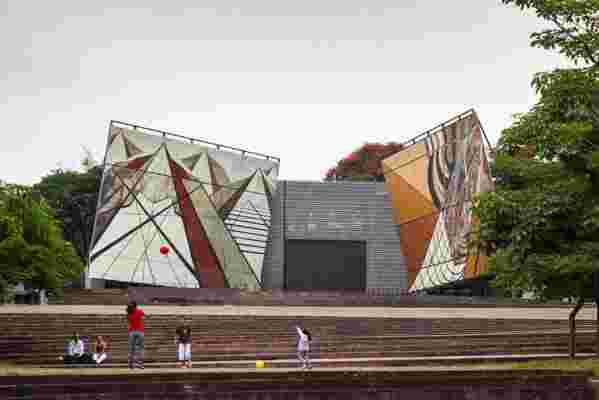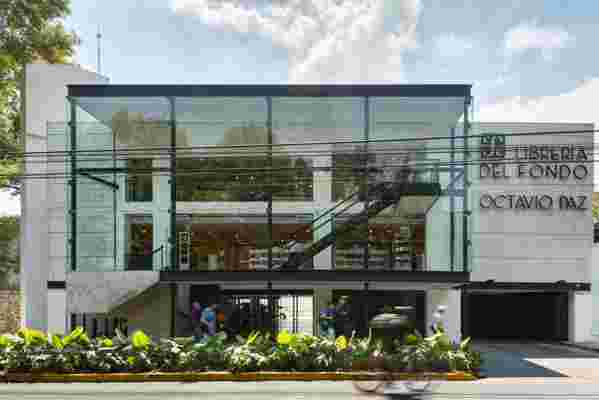The Future of Mexican Architecture with One of Its Leading Young Architects
Frida Escobedo cofounded her first architecture firm at the nascent age of 24. Just three years later she launched a solo practice in her hometown of Mexico City, where she began honing her highly stylized approach to traditional Mexican design. Nothing is off-limits at her practice: From art installations to public spaces to building design, Escobedo brings a fresh perspective to projects across the globe. It’s her work in Mexico, however, that remains closest to her heart. She and her team have made a number of impressive architectural contributions to their country—most notably the Tallera Siqueiros Cultural Center in Cuernavaca and the 2014 renovation of the Octavio Paz library in Guadalajara—with the intention of adding more functional, eco-friendly buildings to Mexico’s pedigree. Prioritizing community needs, cultural identity, and sustainability, AD discussed the ways in which Escobedo plans to take the future of Mexican architecture into her own hands.

Frida Escobedo is forging her own path in contemporary Mexican architecture.
Architectural Digest: What do you appreciate most about contemporary Mexican architecture?
Frida Escobedo: Most of the time we face the fact that there are very little means, but that doesn’t mean we shy away from developing powerful ideas. I also appreciate that craftsmanship is still very present even when we have learned that within this context, good architecture cannot depend on elaborate details or sophisticated materials. On one hand, Mexico City is composed mostly of buildings that were not designed by architects. Most of the housing is self-constructed. The need for space, optimization of materials, and even the expression of aesthetic preferences are outstanding. There is still a lot to learn from these dynamics.
AD: How would you like to see Mexican architecture and infrastructure develop in the future?
FE: In recent years we have seen how some of the most important infrastructure projects are being developed to benefit the car industry: overpasses, new roads, toll urban freeways. Today, the number of new cars exceeds by far the growth of the population, which is quite alarming, and owning a car is seen as a status symbol. I believe that true quality of life within of a city is reflected on how people from every economic background use public transportation.
I also think we should look at the opportunities that public space presents. In Mexico we occupy streets in a very particular manner—it may seem chaotic, but it is actually very complex and organized. Generally, urban renovation plans do not consider this kind of street life in their plans. I believe that instead of fighting it, we should embrace how we use the streets and actually make some processes more efficient.

La Tallera, the courtyard Escobedo designed at the Museo Siqueiros in Cuernavaca, Mexico.
AD: How important is interacting with the community when designing a new project in order to gauge their needs and concerns?
FE: It is the most important thing. We are always trying to find ways to communicate more effectively with the surrounding community.
AD: Tell us about your housing projects that are currently in the works.
FE: We are working on two housing projects. One is medium-income housing in Colonia Popotla. We are lucky enough to be working with a group of young developers who, by offering great quality of space at reasonable prices, are trying to preserve the neighborhoods instead of brazenly trying to gentrify them. Instead of proposing a very dense apartment building, we designed 8 duplex houses plus a tiny individual house. They all share a central courtyard, very much like the vecindad scheme that is very popular in Mexico City.
The second project was commissioned by Infonavit, the Mexican Federal Institute for Workers' Housing. We were challenged to design a progressive growth house that would cost less than $10,000. We consolidated structure and skin to optimize material, labor, and resources. Our second strategy was to use shared walls, which allowed for a significant cost reduction, while also creating the possibility for shared patios. This combination promotes solidarity and strengthens community ties.

Octavio Paz Library in Guadalajara, Mexico.
AD: How does sustainable design factor into your process?
FE: Sustainability shouldn’t be seen as an addition to the creative process; it should be the process.
AD: Has working as a Mexican architect on projects in the U.S. been affected by the country's political climate at all?
FE: I haven’t seen any changes yet, but I am sure we will soon. The architect’s circuit in Mexico is very close, and we have discussed this issue already. Recently, Tatiana Bilbao summoned a large group of architects to think about ways in which we could deal with this situation. Later she invited students and the general public to join the initiative during a lecture at Mextropoli a few weeks ago. We are also trying to build more relationships with institutions, schools, and academics in America and beyond as a way of resistance.